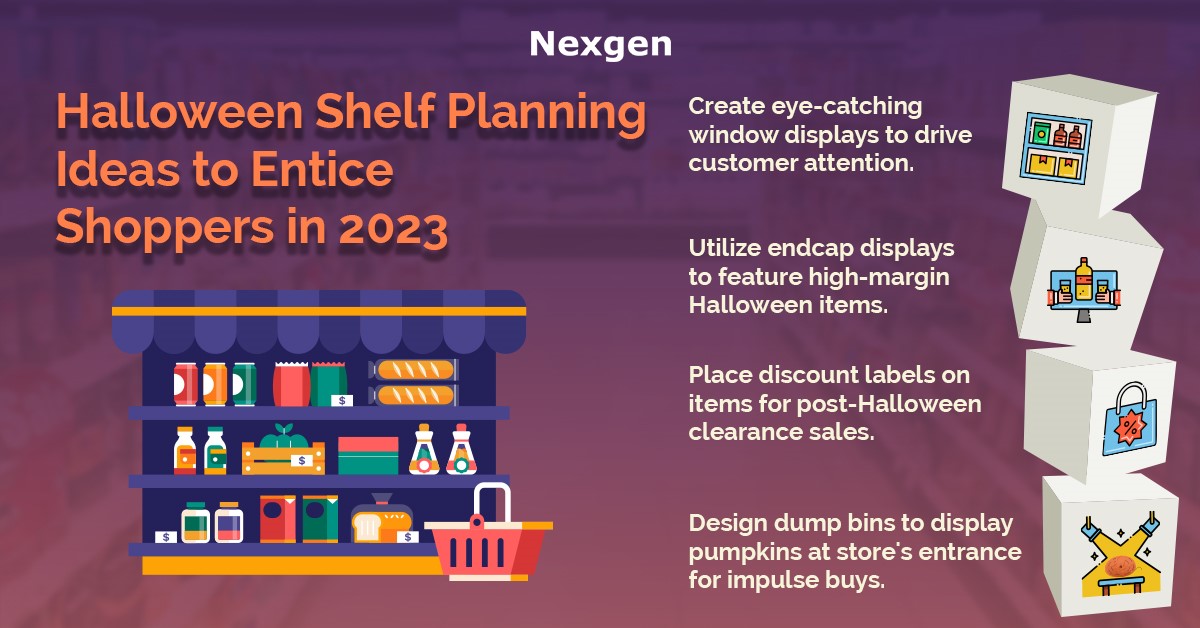The season of black cats, carved pumpkins, witches, spooky decors, and dark costumes is approaching! That is right; Halloween 2023, the spookiest time of the year, is just around the corner, But how do you get started?
Did you know that Halloween has evolved beyond being just a holiday? It has now become a significant time of sales growth, with a $6.1 billion increase in the past 12 years in the U.S. alone. A major part of this sales growth was a result of an effective shelf planning during the Halloween season. To make the most of this spooky season, retailers need to be aware of the latest trends and adopt effective shelf planning ideas with the help of planogram software to drive customer attention. In this blog, we will delve into the Halloween sales trends for 2023 and provide you with insights on how to boost your sales and enhance the shopping experience.
Halloween Sales Trends
- Personalization: Offer customizable Halloween products such as personalized costumes, pumpkin carving kits, and treat bags. Consumers appreciate unique and personalized items that help them stand out during the festivities.
- Inclusivity: Embrace diversity in your Halloween offerings. Ensure that costumes and decorations cater to people of all ages, genders, and backgrounds. Representing a broader audience can help you attract a wider customer base.
- Healthy alternatives: As health-conscious consumers seek alternatives to traditional Halloween treats, consider offering healthier candy options, allergen-free choices, and non-food treats like stickers or small toys.
Shelf Planning Ideas

- Create eye-catching window displays: Your storefront is the first thing a customer notices when they visit the store. So, placing display stands with the help of such as pedestals or ladder shelves can elevate the key items to entice shoppers. You can add Halloween themed decors such as plastic spiders, skeletons or a witch hat to your window displays to drive customer attention.
- Change your endcaps: Utilize endcap displays to feature high-margin Halloween products and impulse buys. Consider showcasing seasonal candies, novelty items, or last-minute costume essentials.
- Place dump bins: Designing dump bins inside the store can increase the chances of impulse buying with the shelf planning software. You can display pumpkins at the entrance of your store, and around the fruit and vegetable section, by filling them with small decorations.
- Add limited-edition Halloween products: You can create limited-edition Halloween-themed items to entice shoppers looking for unique seasonal items. For example, if you own a cake shop, placing Halloween-themed items such as ghost cookies, layered candy corn pie, or pumpkin muffins can attract customers.
- Checkout counters: Use the checkout area for last-minute Halloween purchases. Display small, enticing items like impulse candies, accessories, and novelty items near the cash counters. Group similar candy types together and use decorative containers or jars with labels that showcase the Halloween theme. Display them at varying heights to create visual interest by placing larger items at the back and smaller ones at the front to give a sense of depth.
Strategies for Halloween
- Early marketing: Start your Halloween marketing campaigns early. Use past sales data to identify last year’s best-selling Halloween items and customer shopping patterns. Ensure you have enough stock of popular items and consider using a just-in-time inventory approach to avoid overstocking on less popular products. Place in-store signage with discount labels to build anticipation and generate buzz around your Halloween offerings.
- Customer engagement: Engage with your customers through contests, giveaways, and interactive events. Create a sense of urgency with limited time offers and flash sales to encourage early purchases by highlighting exclusive deals on popular Halloween items.
- Post-Halloween clearance: Plan for post-Halloween clearance sales to move unsold inventory quickly. Consider offering deep discounts on seasonal items to clear space for the next holiday season.
- DIY zones: Set up DIY crafting stations with supplies for making costumes and decorations. Offer instructions and inspiration to encourage customers to purchase crafting materials.
- Seasonal flow: Plan the flow of your store to guide customers through Halloween sections in a logical sequence. Start with decorations, then costumes, followed by candy and party supplies. Place high-margin or trending items at eye level to capture customers' attention. Reserve lower shelves for less popular or bulk items.
Overview of Nexgen POG
Nexgen POG is a robust and user-friendly cloud-based visual merchandising tool. It is designed for quick and efficient planogramming with minimal effort. Planogram in retail can be designed by easily dragging and dropping the products. The multi-device compatibility feature of POG allows you to obtain, share and edit planogram on any device, including your phone. It helps in designing store-specific planograms for increased product visibility and sales.
Get Your Free Trial Now!